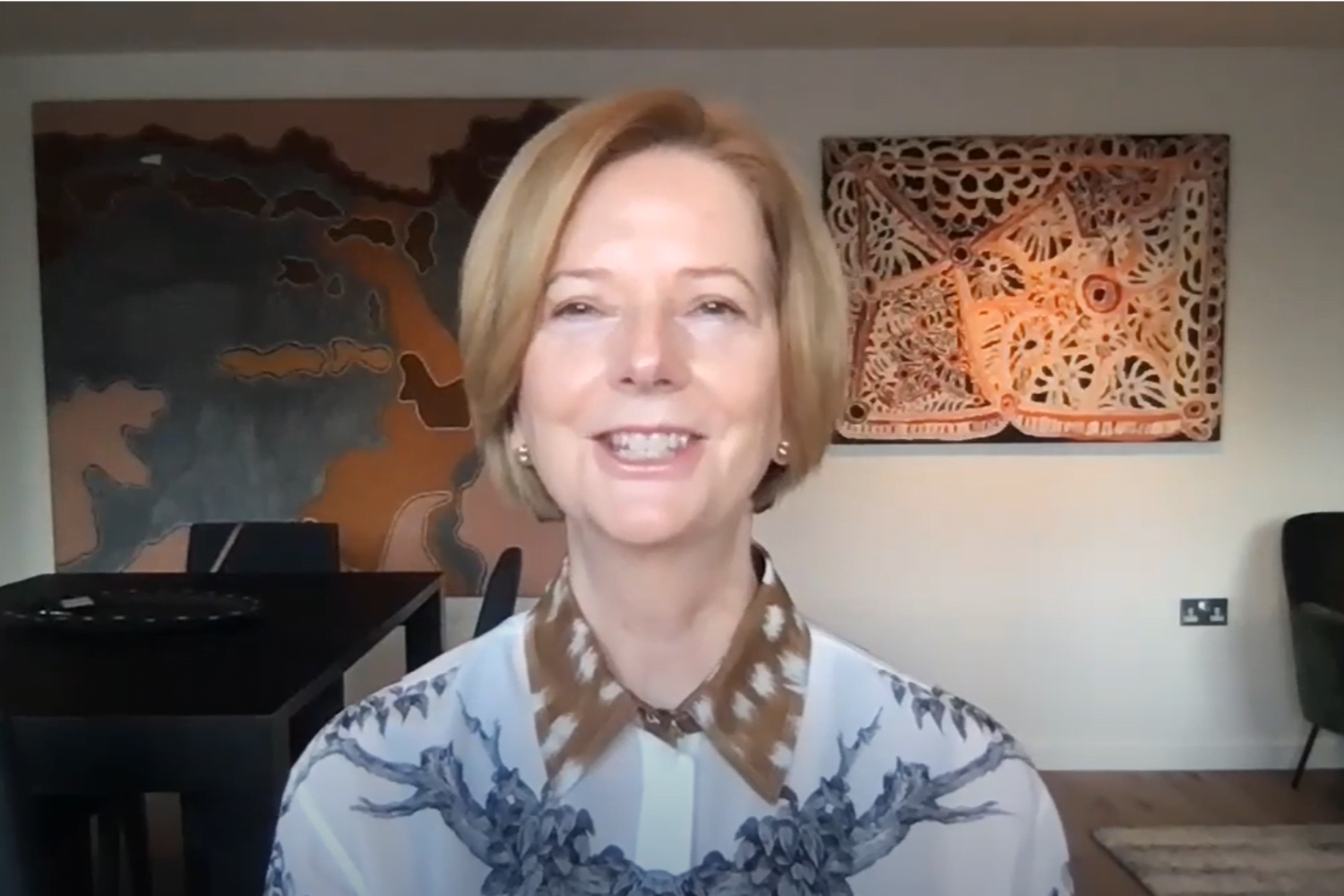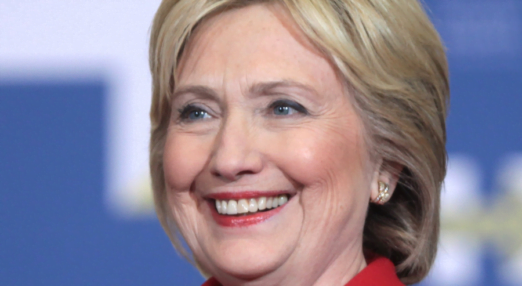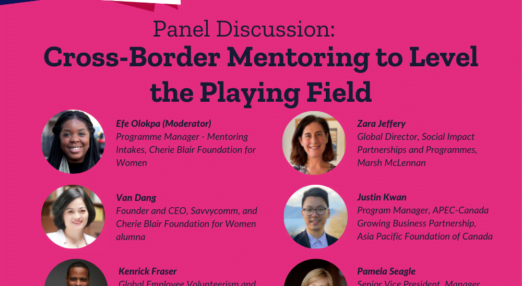Hon. Julia Gillard AC on the power of young women entrepreneurs
27th Prime Minister of Australia Hon. Julia Gillard AC on supporting young women entrepreneurs, raising venture capital and stereotypes facing women leaders.

Hon. Julia Gillard AC was the 27th Prime Minister of Australia. Last year, as part of our 100,000 Women Campaign, we were honoured to have her join our Women Entrepreneurs Mean Business summit to deliver a speech on the power of young women’s entrepreneurship and the stereotypes facing women leaders:
“It’s an absolute pleasure to speak to you today. I want to thank Cherie Blair for her leadership and personal efforts in ensuring that our world is transformed by unleashing a wave of women’s entrepreneurship. Gender equality cannot be achieved unless women are empowered economically. Being able to support yourself is key to having the ability to make choices about your life and forge your own path. However, entrepreneurship is about so much more than the money. It’s about creativity, passion and leadership.
Being able to support yourself is key to having the ability to make choices about your life and forge your own path.
Let me tell you a story which demonstrates this so well. Doris Mapongi lives in Tanzania and runs a successful food processing businesses selling peanut butter, jam and chilli sauce. She delivers to homes and offices, which has extended her reach and proved sustainable during the COVID-19 pandemic. She’s become a role model to girls at her former secondary school, and, through her profits, Doris now looks after her five siblings, supporting them all to go to school. Doris’ step-dad has changed his way about thinking about women’s potential and the importance of education.
Doris explains: ‘My family’s respect for me has increased a lot. They now get some of their basic needs from the financial support I provide. My stepfather, when he saw my progress and the support I bring to the family, actually apologised to me, and said if he’d known my potential, he would have supported me more in my education. I was selected as the chairperson of my family, even though there are older uncles and aunties, because of the success I have had. I now always lead family discussions when there are important matters to cover.’
Doris’ individual story is heart-warming, compelling, and a great example of the larger story. Women’s entrepreneurship and business acumen turbo-charges economic growth. Research shows that female entrepreneurs generate more revenue than their male counterparts. Globally, for every one US dollar raised, women-owned start-ups generated 78 cents in revenue, while start-ups run by men only generated 31 cents. Teams of diverse Founders, meaning more than one gender or more than one race or ethnicity represented, achieve better financial outcomes, including 30 percent higher multiples on invested capital. Start-ups with at least one female Founder received a 63 percent better valuation than all-male teams. When US venture capital firms increased the proportion of female partners, they increased their profitable exists by 9.7 percent and increased a 1.5 percent amount in their overall fund return.

With all this good news, it’s hard to explain why there are still so many barriers existing for women entrepreneurs, but tragically those barriers are there. The World Economic Forum, in its 2021 report, tells us that at the current rate of change, it will take 136 years to close the gender gap worldwide. The forum tracks gender gaps in four domains: heath; education; political empowerment and economic empowerment. The gender gap in economic empowerment has the second-largest of the four gaps tracked, but it is the one with the slowest rate of change. According to this year’s index, 58 percent of the gap has been closed so far, and there was a marginal improvement since the 2020 edition of the report. But, the World Economic Forum estimates it will take 267 years to close the remaining gap, a statistic which I am sure appals all of us.
This report, and our own lived experience, is telling us that gender inequality, which manifests as both structural barriers and negative stereotyping continues to hold women back. Basically, women entrepreneurs can face everything, from not being safe or treated fairly when trying to set out a stall in the marketplace, to being systematically underestimated and told to go back home to their children. These barriers exist globally, and no country has a level playing field for women generally or women entrepreneurs in particular.
One way of measuring the inequality is to look at venture capital distribution, because this source of finance is key to enabling new businesses and start-ups, to grow and scale. In 2020, globally, only 2.3 percent of venture capital funding went to start-ups with a women-only founding team. We can turn these statistics around and find that in the US 85 percent of venture capital funding (136.5 billion US dollars) went to white, male Founders in 2019.
These types of barriers are especially pressing in low-income countries. Indeed, venture capital can be almost impossible to find in countries with less developed financial and legal institutional frameworks. But there are additional barriers as well.
Women are often uniquely excluded from financial investment processes in developing countries, due to a lack of land ownership. For example, in Kenya, women only own 1% of land outright, which leads to challenges in putting up collateral against a loan from a bank and limits access to both formal and informal sources of credit. Lack of access to finance is emblematic of a deeper set of discriminations. Girls are taught from the youngest of ages that the world of business is for men, and the home front is for women. When a woman, through necessity or passion, decides she will set up her own business, it is often assumed she will fail. Exclusion from business networks can prevent her being able to grow her enterprise. She may also be viewed as a soft target for exploitation by others. She may be physically at risk in moving around as she needs to, to pursue her work. Then on top of this is layered the lack of access to financing, to enable her business to grow.
Women are often uniquely excluded from financial investment processes in developing countries, due to a lack of land ownership.
How do we change this picture? Let me offer a few ideas. One: Overseas development assistance from high income countries can and should better support girls’ education. For the last seven years, I chaired the Global Partnership for Education, which is the international body dedicated to improving school education in developing countries. GPE is trying to extend quality schooling to every child and solve the problem that in our world today 250 million children of school age are not in school, and hundreds of millions more are in school, but they are of such poor quality that not even the basics of literacy and numeracy are learned. Disproportionately, the excluded children are girls, and for many, including the girls of Afghanistan, the outlook is becoming bleaker. This is a collective problem global action can address.
Overseas development assistance can also support microfinance initiatives and other women’s economic empowerment measures. These models work. For example, in the Philippines, micro-finance institutions largely serve female customers, and provide investments which promote women’s financial inclusion.
There is a role here too for private sector funding. For example, in 2020 impact investor Leapfrog reached 119 million women and girls with essential services including healthcare and financial tools, consequently enabling them and their families to survive and thrive. I’m proud to serve on Leapfrog’s Global Advisory Council.
It is also important to support women-led companies specialising in venture capital, such as All Raise, How Women Invest, and Invest EU, which all aim to create a funding ecosystem in which women and non-binary individuals from diverse backgrounds lead.
But overcoming the challenges requires women to find a way to support other women, by creating more female mentorship and networking opportunities, elevating existing female role-models and, through research, spotlighting the major challenges and the best strategies for overcoming them. This is exactly what the 100,000 Campaign aims to do, and why I am so supportive of its efforts. This campaign is truly transformative for the 100,000 women involved, and the millions more it will inspire. It is a delight to be part of it, and I wish you all the best as you participate in these important global discussions.“
Read more from the Women Entrepreneurs Mean Business summit
-

Hillary Clinton on women’s equality and breaking glass ceilings
Hillary Clinton and journalist Barkha Dutt discuss breaking gender stereotypes and empowering women entrepreneurs.
Read more
-

Panel discussion: Cross-Border Mentoring to Level the Playing Field
A panel discussion from the Cherie Blair Foundation for Women’s Women Entrepreneurs Mean Business summit, exploring and challenging the gender stereotypes holding women entrepreneurs back from success and equality. Because we won’t wait 250+ years for women to have economic equality.
Read more
-

Rebecca Enonchong on digital entrepreneurship
Rebecca Enonchong on defying stereotypes and driving change for women in digital entrepreneurship.
Read more